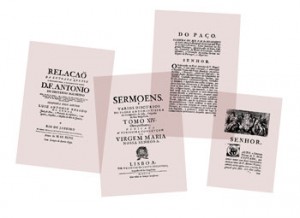
FAC--SÍMILES: WWW.BRASILIANA.USP.BRThe first book to be printed in Brazil (1747) and pages from Sermões (1679-1748) FAC--SÍMILES: WWW.BRASILIANA.USP.BR
The previous collection of books, manuscripts and periodicals, painstakingly collected in the course of 80 years by journalist, lawyer and businessman José Mindlin, is beginning to leave the bookshelves of his private library located in São Paulo City’s Brooklyn neighborhood to appear on the internet. Since June, it has been possible to read, copy and print books that are part of the most comprehensive private collection of books on Brazilian topics. This collection was started in 1927, when Mindlin, who was 13 years old at the time, started buying antique books. The books are very rare, some of them come from the 16th century, and the focus is Portuguese and Brazilian literature, travelers’ journals, historical and literary manuscripts, periodicals, scientific books, educational books, art books and iconographic books. The collection, in digital form, thanks to the Brasiliana Digital program, now totals approximately three thousand documents (books, pamphlets, images, maps, etc.), is available at www.brasiliana.usp.br (some of the titles are listed on this page.
Brasiliana Digital is part of a broader project, the Brasiliana USP, coordinated by historian István Jancsó, from the Brazilian Studies Institute/IEB of the University of São Paulo/USP. In 2006, José Mindlin, who is now 95 years old, donated part of his library – namely, the Brasiliana collection, consisting of seventeen thousand volumes – to USP, on condition that a building would be built to house the collection so that the books were looked after as carefully and delicately as they had been when they were stored in the building that the bibliophile built on his property. The university engaged in fund raising activities to comply with Mindlin’s request, and was able to get public and private funding for this project. Construction on a new building located on USP’s Cidade Universitária campus is scheduled to begin this year. The building will house the collection donated by Mindlin and the new facilities of the IEB. “The idea is to create a center that will make Brazilian culture and history accessible to the entire population, with no distinction”, Jancsó explains.
The Brasiliana Digital project includes approximately twelve thousand titles that will be digitalized; all of them are in the public domain. To this end, a robotic digitalization system for bound books was purchased from U.S., company Kirtas Tech. The robot, nicknamed “Maria Bonita” by the staff of the Brasiliana Digital Laboratory, scans up to 2,400 pages an hour (approximately 40 books per day).
The Brasiliana Digital project is coordinated by historian Pedro Puntoni from USP. It is funded by FAPESP, which has granted R$ 980 thousand. This amount is enough to buy Maria Bonita (US$ 220 thousand) and pay 15 scholarship recipients. “Thirty professionals are involved in this project, among whom we have professors, researchers, technicians and scholarship recipients working on the digitalization”, says Puntoni. The books can be researched according to their content and are available for printouts (300 DPIs) or for viewing on the screen (100 DPIs). The Polytechnic School/Poli/USP is also participating in the project by helping handle and develop the software. “Later on, we will continue using the robot for other projects that come up in the future”, says professor Edson Gomi, from Poli. This project has allowed the preservation of rare books and has guaranteed unrestricted access to them. Mindlin’s words -“we die and books remain” – are very true.
Republish